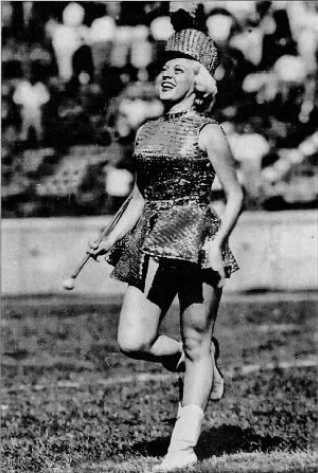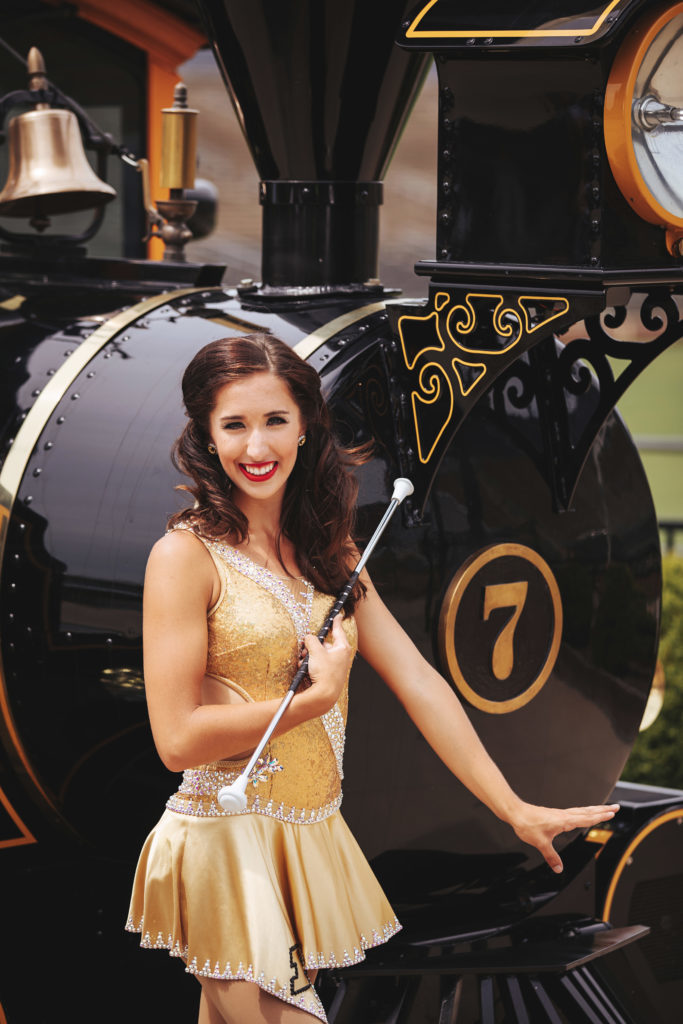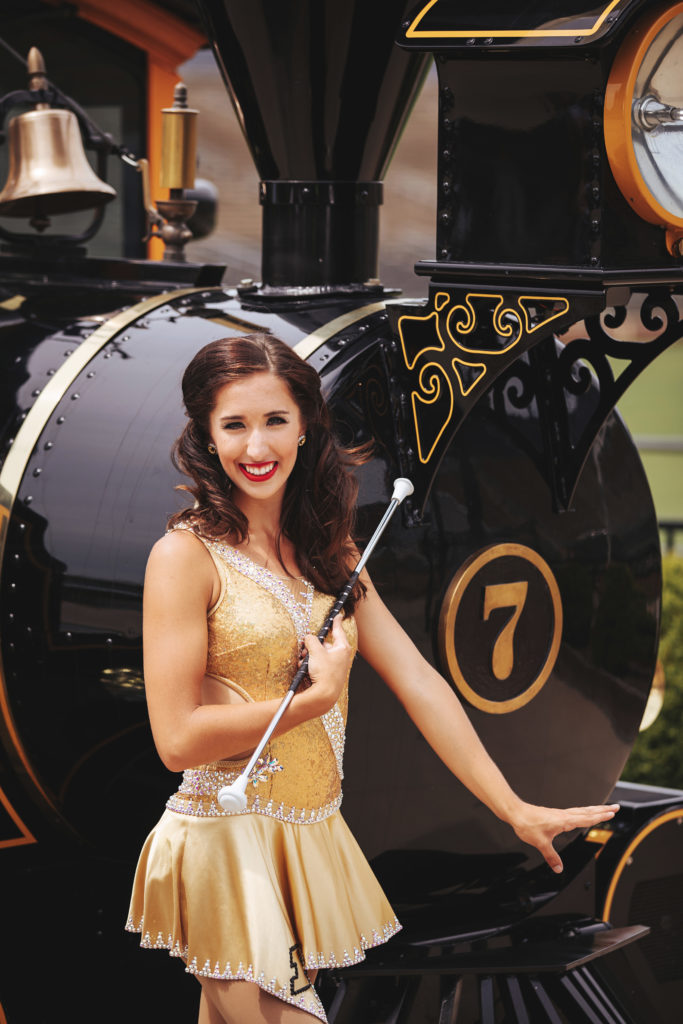Posted on November 21, 2019 by small20
The Golden Girl’s Golden History
by Jackie Krutsch
Even though the position of Purdue’s Golden Girl was created just sixty-five years ago, this tradition of the gold-sequined twirler is one that is very well known, not only at Purdue, but across the country. The image of the Golden Girl has remained very consistent since its start, and Christy Stallings, the Golden Girl in 2004, still held this image fifty years later. Stallings, ready for a game-day performance, was “dressed in a short black dress with gold sequin trim, with sunny blond hair topped with gold ribbon” and was described as looking “every inch the Golden Girl.” [1] Although the uniform has been adjusted, the color of hair of Golden Girls has changed, and the style of tricks that are performed every game have advanced, the essence of the Golden Girl has remained the same. Purdue’s Golden Girl has, and continues to be, the premier twirler and embodiment of women’s sports traditions at Purdue University.
Purdue’s group of Bands and Orchestras consists of multiple bands, orchestras, and other ensembles that all have a unique composition and sound. One of the most well-known ensembles is the “All American” Marching Band, which is made up of over 390 musicians and is accompanied by many auxiliary groups, including the Golden Silks Color Guard, Purdue Golduster Dance Team, All-American Twirling Team, Silver Twins, Girl-In-Black, Miss Boilerette, and of course, the renowned Golden Girl. The position of Golden Girl was created in 1954 by the band director at the time, Al G. Wright. In 1954, Purdue had a very talented quarterback, Lenny Dawson, whom the press often referred to as the “Golden Boy,” since Purdue’s colors are gold and black. The name “Golden Boy” became well-liked by Purdue fans, so when Al Wright was considering names for his new twirling lead, he thought “Golden Girl” was the perfect fit. [2] Purdue now had two prominent leaders of the football team and band, the Golden Boy and Golden Girl. There are other stories regarding how the name “Golden Girl” was chosen. One story involves the idea that Al’s wife, Gladys Wright, created the name around the time the newspaper described Len Dawson as the “Golden Boy”. Another story is that Wright came up with the name at Purdue’s football game against Notre Dame in 1954 when he saw the new twirler in her all-gold uniform and thought the name to be appropriate. [3] The Golden Girl was the first stand-alone twirling position to be started, then the Silver Twins were created in 1960, the Girl in Black followed in 1962, and the competitive twirling team was created in 2001. [4] Each solo twirler or twirling unit had its own look and performance style. Although the first twirling position was not formed until 1954, a team of twirlers were started in 1939 when the director of the band, Paul Spotts Emrick, allowed women to join the band since “he felt there weren’t enough activities for women on campus. Emrick allowed them to march and twirl, but they weren’t able to play instruments in the band.” [5] Progress was made for women’s involvement in collegiate activities, specifically sports, by the creation of a twirling team, but women were still limited in what activities they could join. At this time, women were clearly viewed as being capable enough to twirl a baton at football games but not play their instrument at these games.
The Golden Girl is most often recognized throwing her baton high into the sky at the home football games, but the role and responsibilities of Purdue’s elite twirler span much further. The first Golden Girl, Juanita Carpenter Richardson, held the position from 1954 until 1956. She was recruited by Al Wright to be the top twirler, but since then, Golden Girls have received this title after years of hard work and a comprehensive audition. Due to the competitive nature of becoming Golden Girl, “only 24 twirlers have known the thrill of strutting into Ross-Ade Stadium amid flags, plumes, and the blare of a marching band to perform solo before 67,000 as Purdue’s own Golden Girl.”[6]

The formal process of becoming a twirler at Purdue includes auditions and interviews, both of which demonstrate to the judges the candidates’ “athletic ability, intelligence, poise, discipline and maturity,” all of which are taken into consideration when choosing the next Golden Girl. [7] Many Golden Girls hold the position for consecutive years, but each year they are required to re-audition regardless of their present title as Golden Girl. Multiple Golden Girls have been members of the Purdue twirling team prior to holding their solo title.
Soon after the formation of the Golden Girl, other twirling roles were created, and twirling received a lot of attention from spectators, fans, and the press. Purdue became well known for their twirlers and young women practiced and auditioned for spots as Purdue’s twirlers each year. Not only did the title of Golden Girl hold weight as being a well-known twirling position, but the Golden Girl became an icon and ambassador of the University. Sports fans throughout the United States knew about Purdue’s Golden Girl, and the Golden Girl often interacted with, gave speeches, and performed for other university students, alumni, sports fans, and more. Women who participated in twirling were college athletes during the passing of Title IX and the evolution of college athletics. As a result, the twirling team faced similar struggles as other women’s teams, including limited resources such as gym space and funding. Due to these disparities between women’s and men’s teams, “the Golden Girl weathered the women’s liberation movement and the rise of women’s sports. It endured dips in twirling’s popularity. It even survived two brunettes — for years, only blondes were considered.” [8]

Changes to Purdue’s twirling program have occurred over its sixty-five years of existence; one of the largest and most talked about changes being the acceptance of a Golden Girl who didn’t have golden hair. In 1995, the first brunette Golden Girl, Dawn Vardaman, was chosen after forty-one years of twirlers being accepted into the program only if they were blonde. Even though this inclusion of a Golden Girl who was not blonde does not seem as though it is a large change, “it marks a change at Purdue. It says the Golden Girl is about baton twirling and projecting a positive image for Purdue, not hair color.” [9]
Until Vardaman, the look of the Golden Girl had been very consistent, and Vardaman was criticized by a few for ‘breaking’ a longstanding tradition, even though the look of the golden girl evolved throughout the years. Since Vardaman, women auditioning to be the next Golden Girl have not been deterred from auditioning due to their hair color. Another aspect of the twirler’s look that has changed is the uniform. The Golden Girl’s uniform stirred excitement across campus in the 1950s when Juanita Carpenter Richardson debuted her shiny, gold-sequined attire at the games, since “fans were used to seeing majorettes in slacks and long-sleeved jackets. Carpenter’s short skirt caused a sensation on a campus where men still outnumbered women eight to one. Fraternity boys would lie down in the street so that she’d have to walk over them as the band marched to Ross-Ade.” [10]
As the Golden Girl, and twirling at Purdue, became more well known, the talent level of the women who auditioned continued to rise, and the Golden Girl became one of the top twirlers around the world. Golden Girls have competed in competitions across the country and globe, they have travelled with the Marching Band to Bowl games and Parades, and Golden Girl MerrieBeth Cox even competed on the USA Twirling Team in 2012 at the World Championships. [11] Purdue’s twirling has experienced the additions of solo twirlers and a twirling team, adjustments to the hair color and uniforms of the athletes, and the rise in talent of the women involved throughout the sport’s history. Despite these variations, the Golden Girl remains a unique part of Purdue’s athletic tradition and image.
[1] Journal & Courier: She hasn’t lost her golden touch, 8 April 2004, Customs and Traditions — Golden Girl Vertical Files, Purdue Archives and Special Collections, Purdue University Libraries.
[2] The Lafayette Leader: A New Dawn for the Golden Girl, 25 August 1988, Musical Organizations 1980-89 Vertical Files Purdue Archives and Special Collections, Purdue University Libraries.
[3] Journal & Courier: Purdue’s first Golden Girl dies, 7 January 2010, Customs and Traditions — Golden Girl Vertical Files, Purdue Archives and Special Collections, Purdue University Libraries.
[4] Purdue University News: Purdue Marching Band selects solo twirlers, 27 August 1999, Customs and Traditions — Golden Girl Vertical Files, Purdue Archives and Special Collections, Purdue University Libraries.
[5] All American Twirling Team, Purdue University Purdue Bands and Orchestras. https://www.purdue.edu/bands/ensembles/auxiliaries/all-american-twirlers/.
[6] Journal & Courier: Purdue’s Golden Girls celebrate 50 years of strutting their stuff, 21 September 2009, Customs and Traditions — Golden Girl Vertical Files, Purdue Archives and Special Collections, Purdue University Libraries.
[7] Journal & Courier: Purdue’s Golden Girls, 2009.
[8] Journal & Courier: Purdue’s Golden Girls, 2009.
[9] Journal & Courier: A new look for Purdue’s Golden Girl, 18 September 1995, Customs and Traditions — Golden Girl Vertical Files, Purdue Archives and Special Collections, Purdue University Libraries.
[10] Journal & Courier: Purdue’s Golden Girls, 2009.
[11] Purdue University News: Purdue’s Golden Girl going for more gold at World Championships, 29 March 2012, Customs and Traditions — Golden Girl, Purdue Archives and Special Collections, Purdue University Libraries.
Image References not available.
